FOLLOWS ARE MANY EXCITING EXHIBITS AND ART EVENTS. CONTACT EACH VENUE DIRECTLY FOR CONFIRMATION AND TICKETING.
CURRENT EVENTS:
################################################
PEABODY ESSEX MUSEUM For complete museum and exhibition details visit www.pem.org
EnChroma glasses are now available to color-blind visitors to see artworks in vibrant hues!
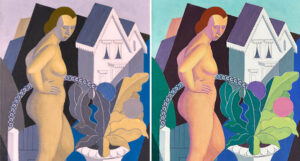 .Ambrose Webster, Webster House, Provincetown (detail), 1931. Oil on canvas. The Sheila W. and Samuel M. Robbins Collection. 2015.44.66. Peabody Essex Museum. Photo by Kathy Tarantola/PEM.
.Ambrose Webster, Webster House, Provincetown (detail), 1931. Oil on canvas. The Sheila W. and Samuel M. Robbins Collection. 2015.44.66. Peabody Essex Museum. Photo by Kathy Tarantola/PEM.
OPENS MAY 17 :THE YU KIL-CHUN GALLERY OF KOREAN ART AND CULTURE
 Artists in Korea, Hwarot (bridal robe), late 18th century. Silk and rice paper. Gift of Yamanaka and Company, 1927. E20190.F. Peabody Essex Museum. The Peabody Essex Museum in Salem brings this superlative collection that reflects Korea and Korean life during the late Joseon dynasty (1392-1910) and early 20th century. It was the integral time when Korea first opened its doors to the West. This early Korean collection was primarily formed by Edward Sylvester Morse, director of the Peabody Academy of Science (a predecessor organization to PEM). He proactively pursued Korean acquisitions during his tenure (1880–1914). One of the most important groups of works Morse acquired is a set of eight Korean musical instruments that were exhibited at the World’s Columbian Exposition of 1893. PEM’s connection with Korea was also strengthened by Yu Kil-Chun (1856–1914), the reformist scholar and politician who came to the U.S. as a member of the first Korean delegation and lived near Salem for nearly a year. Yu Kil-Chun and other early travelers between the U.S. and Korea donated many meaningful and foundational works to the museum’s collection. The fascinating stories of these early pioneers is explored in PEM’s Yu Kil-Chun Korean Art Gallery alongside masterworks from the museum’s renowned Korean textile collection, superb 19th century paintings and the work of contemporary Korean and Korean American artists. The Yu Kil-Chun Gallery of Korean Art and Culture at PEM is made possible with the support of the Korea Foundation. Generous support is also provided by the National Museum of Korea; The E. Rhodes and Leona B. Carpenter Foundation; the Overseas Korean Cultural Heritage Foundation and Samsung Foundation, Korea; and an anonymous donor. www.pem.org
Artists in Korea, Hwarot (bridal robe), late 18th century. Silk and rice paper. Gift of Yamanaka and Company, 1927. E20190.F. Peabody Essex Museum. The Peabody Essex Museum in Salem brings this superlative collection that reflects Korea and Korean life during the late Joseon dynasty (1392-1910) and early 20th century. It was the integral time when Korea first opened its doors to the West. This early Korean collection was primarily formed by Edward Sylvester Morse, director of the Peabody Academy of Science (a predecessor organization to PEM). He proactively pursued Korean acquisitions during his tenure (1880–1914). One of the most important groups of works Morse acquired is a set of eight Korean musical instruments that were exhibited at the World’s Columbian Exposition of 1893. PEM’s connection with Korea was also strengthened by Yu Kil-Chun (1856–1914), the reformist scholar and politician who came to the U.S. as a member of the first Korean delegation and lived near Salem for nearly a year. Yu Kil-Chun and other early travelers between the U.S. and Korea donated many meaningful and foundational works to the museum’s collection. The fascinating stories of these early pioneers is explored in PEM’s Yu Kil-Chun Korean Art Gallery alongside masterworks from the museum’s renowned Korean textile collection, superb 19th century paintings and the work of contemporary Korean and Korean American artists. The Yu Kil-Chun Gallery of Korean Art and Culture at PEM is made possible with the support of the Korea Foundation. Generous support is also provided by the National Museum of Korea; The E. Rhodes and Leona B. Carpenter Foundation; the Overseas Korean Cultural Heritage Foundation and Samsung Foundation, Korea; and an anonymous donor. www.pem.org
MAY 17–JAN. 25, 2026: JUNG YEONDOO…BUILDING DREAMS
 Han Sang Kyun, Portrait of Jung Yeondoo. © Hang Sang Kyum. Image courtesy of Jung Yeondoo The peabody Essex Museum encourages visitors you to pause and wonder about the people next door? Who they are and what they dream about? Artist Jung Yeondoo invites you to look closer at your neighbors — the strangers you might pass in an apartment elevator or a busy street — and imagine their dreams. This exhibition in PEM’s Jeffrey P. Beale Gallery highlights two major series of photographic works: Evergreen Tower (2001) and Bewitched (2001). After attending art school in London, Jung returned to Seoul in the early 2000s and discovered that the city had become a “concrete forest” of high-rise apartment complexes.Among his new neighbors, Jung observed that the comforts of urban, middle-class life had also produced a sense of anonymity and isolation. Driven by curiosity, Jung began to ask the people around him about their hopes and aspirations and began using photography to connect with others.www.pem.org
Han Sang Kyun, Portrait of Jung Yeondoo. © Hang Sang Kyum. Image courtesy of Jung Yeondoo The peabody Essex Museum encourages visitors you to pause and wonder about the people next door? Who they are and what they dream about? Artist Jung Yeondoo invites you to look closer at your neighbors — the strangers you might pass in an apartment elevator or a busy street — and imagine their dreams. This exhibition in PEM’s Jeffrey P. Beale Gallery highlights two major series of photographic works: Evergreen Tower (2001) and Bewitched (2001). After attending art school in London, Jung returned to Seoul in the early 2000s and discovered that the city had become a “concrete forest” of high-rise apartment complexes.Among his new neighbors, Jung observed that the comforts of urban, middle-class life had also produced a sense of anonymity and isolation. Driven by curiosity, Jung began to ask the people around him about their hopes and aspirations and began using photography to connect with others.www.pem.org
THROUGH JUNE 15, 2025: NARWHAL…REVEALING AN ARTIC LEGEND
 The Peabody Essex Museum invites visitors to dive deep into the world of narwhals. These unique ocean dwellers, sometimes called the “unicorns of the sea,” spend their lives in the Arctic waters of Canada, Greenland, Norway and Russia. Learn about their changing Arctic ecosystem through firsthand accounts of scientists and Inuit community members. Hear soundscapes of the Arctic, including the evocative vocalizations of the narwhal, and touch an 8-foot-long cast of a real narwhal tusk. On view in The Dotty Brown Art & Nature Center, this family-friendly, interactive exhibition is part of PEM’s interdisciplinary Climate + Environment Initiative.
The Peabody Essex Museum invites visitors to dive deep into the world of narwhals. These unique ocean dwellers, sometimes called the “unicorns of the sea,” spend their lives in the Arctic waters of Canada, Greenland, Norway and Russia. Learn about their changing Arctic ecosystem through firsthand accounts of scientists and Inuit community members. Hear soundscapes of the Arctic, including the evocative vocalizations of the narwhal, and touch an 8-foot-long cast of a real narwhal tusk. On view in The Dotty Brown Art & Nature Center, this family-friendly, interactive exhibition is part of PEM’s interdisciplinary Climate + Environment Initiative.
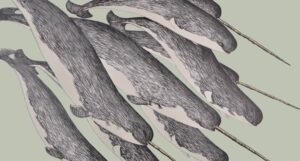 The exhibit includes contemporary Inuit sculptures and prints and a historic book from PEM’s Phillips Library collection. Organized by the Smithsonian Institution Traveling Exhibition Service in collaboration with the Smithsonian’s National Museum of Natural History, according to Smithsonian Magazine, “research into tusk function and feeding strategies have brought this elusive animal into the news, while declining sea-ice cover has drawn new attention to its Arctic ecosystem.” The world population of these recognizable creatures is currently estimated to be around 173,000 individuals, but climate change in the Arctic poses a significant threat. “With its remarkable spiral tooth, the narwhal has inspired legends and fascinated people across cultures for centuries,” said Jane Winchell, PEM’s Curator of Natural History and The Sarah Fraser Robbins Director of the Dotty Brown Art & Nature Center. “These mysterious creatures inspire a sense of wonder and are hard to see in person, since they do not survive in zoos and aquariums. You’d have to travel to the Arctic to find them, because they are uniquely adapted to live among sea ice much of the year.” “The future of narwhals is uncertain in a rapidly changing Arctic, but Inuit and scientific communities are collaborating to help us to better understand these animals and help ensure the survival of this beloved species,” said Winchell. Narwhal:
The exhibit includes contemporary Inuit sculptures and prints and a historic book from PEM’s Phillips Library collection. Organized by the Smithsonian Institution Traveling Exhibition Service in collaboration with the Smithsonian’s National Museum of Natural History, according to Smithsonian Magazine, “research into tusk function and feeding strategies have brought this elusive animal into the news, while declining sea-ice cover has drawn new attention to its Arctic ecosystem.” The world population of these recognizable creatures is currently estimated to be around 173,000 individuals, but climate change in the Arctic poses a significant threat. “With its remarkable spiral tooth, the narwhal has inspired legends and fascinated people across cultures for centuries,” said Jane Winchell, PEM’s Curator of Natural History and The Sarah Fraser Robbins Director of the Dotty Brown Art & Nature Center. “These mysterious creatures inspire a sense of wonder and are hard to see in person, since they do not survive in zoos and aquariums. You’d have to travel to the Arctic to find them, because they are uniquely adapted to live among sea ice much of the year.” “The future of narwhals is uncertain in a rapidly changing Arctic, but Inuit and scientific communities are collaborating to help us to better understand these animals and help ensure the survival of this beloved species,” said Winchell. Narwhal:
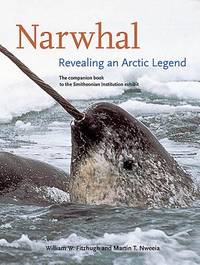 “Revealing an Arctic Legend” is a 229-page companion publication edited by William Fitzhugh, director of the Smithsonian Arctic Studies Center. This publication examines the latest research in narwhal biology, art and climate science. Illustrated by more than a dozen photographers and graphic artists. Artists and scientists throughout history celebrate this elusive whale and its extraordinary tusk. From Flemish unicorn tapestries, Inuit traditional knowledge and scientific research comes a tale of discovery from the top of the world, a place where climate change is rapidly transforming one of the harshest environments on Earth. How did the narwhal tusk become the horn of the fabled unicorn? What legends do the Inuit teach about this majestic but elusive denizen? What have scientists discovered about the function of its tusk? Explore with whale biologists as they capture live narwhals to answer questions of narwhal biology, migration, population and behavior. Ponder the evolutionary history of the narwhal through paleontology and genetic science. Contemplate the fate of northern regions, animals and peoples in a rapidly warming Arctic, and experience the insights and observations of Inuit hunters who have lived with the narwhal for thousands of years. This book is available in the PEM Shop. For more information visit www.pem.org
“Revealing an Arctic Legend” is a 229-page companion publication edited by William Fitzhugh, director of the Smithsonian Arctic Studies Center. This publication examines the latest research in narwhal biology, art and climate science. Illustrated by more than a dozen photographers and graphic artists. Artists and scientists throughout history celebrate this elusive whale and its extraordinary tusk. From Flemish unicorn tapestries, Inuit traditional knowledge and scientific research comes a tale of discovery from the top of the world, a place where climate change is rapidly transforming one of the harshest environments on Earth. How did the narwhal tusk become the horn of the fabled unicorn? What legends do the Inuit teach about this majestic but elusive denizen? What have scientists discovered about the function of its tusk? Explore with whale biologists as they capture live narwhals to answer questions of narwhal biology, migration, population and behavior. Ponder the evolutionary history of the narwhal through paleontology and genetic science. Contemplate the fate of northern regions, animals and peoples in a rapidly warming Arctic, and experience the insights and observations of Inuit hunters who have lived with the narwhal for thousands of years. This book is available in the PEM Shop. For more information visit www.pem.org
JUNE 17 – SEPT. 21: MAKING HISTORY….200 YEARS OF AMERICAN ART FROM THE PENNSYLVANIA ACADEMY OF ART
 Charles Willson Peale, The Artist in His Museum (detail), 1822. Oil on canvas. Courtesy of the Pennsylvania Academy of the Fine Arts, Philadelphia. Gift of Mrs. Sarah Harrison (The Joseph Harrison, Jr. Collection). 1878.1.2. Photograph by Adrian Cubillas. Since the founding of the United States, artists have played a key role in shaping the nation’s history and refraining shared perspectives of pressing social and political issues. By embracing the stories of an array of artists, Making History offers a range of narratives on American art, culture, and community. Assembled together, these works show us how artists shape our contemporary understanding of America’s past, present, and future. Discover this formidable collection of iconic works that have been perfectly places alongside stellar pieces by traditionally and often underrepresented artists. This exhibition presents 85 works from the historic collection of the Pennsylvania Academy of the Fine Arts. It takes viewers on a journey across time, medium and identity. The exhibition offers new narratives of the history of American art and reveals American artists as they have always been: a diverse group that includes women, artists of color and members of the LGBTQIA+ community. Since the founding of the United States, these artists have played a vital role in crafting and continually retelling the nation’s history. Enjoy iconic American works in a new light and find new favorites. Featured artists include Edward Hopper, Winslow Homer, Gilbert Stuart, Georgia O’Keeffe, Horace Pippin, Childe Hassam, Thomas Hart Benton, Mary Cassatt and Stuart Davis, among others. The European art establishment of the 17th century introduced the term “history painting” to describe scenes that drew upon ancient history, mythology, and the Bible. At the nation’s founding, American artists began altering this approach by depicting contemporary stories, as if to show history was in the making all around them. Alice Neel extended this approach into the early 20th century when she depicted impoverished women and children who slipped through the cracks of government bureaucracy during the Great Depression in her painting, Investigation of Poverty at the Russell Sage Foundation (1933).
Charles Willson Peale, The Artist in His Museum (detail), 1822. Oil on canvas. Courtesy of the Pennsylvania Academy of the Fine Arts, Philadelphia. Gift of Mrs. Sarah Harrison (The Joseph Harrison, Jr. Collection). 1878.1.2. Photograph by Adrian Cubillas. Since the founding of the United States, artists have played a key role in shaping the nation’s history and refraining shared perspectives of pressing social and political issues. By embracing the stories of an array of artists, Making History offers a range of narratives on American art, culture, and community. Assembled together, these works show us how artists shape our contemporary understanding of America’s past, present, and future. Discover this formidable collection of iconic works that have been perfectly places alongside stellar pieces by traditionally and often underrepresented artists. This exhibition presents 85 works from the historic collection of the Pennsylvania Academy of the Fine Arts. It takes viewers on a journey across time, medium and identity. The exhibition offers new narratives of the history of American art and reveals American artists as they have always been: a diverse group that includes women, artists of color and members of the LGBTQIA+ community. Since the founding of the United States, these artists have played a vital role in crafting and continually retelling the nation’s history. Enjoy iconic American works in a new light and find new favorites. Featured artists include Edward Hopper, Winslow Homer, Gilbert Stuart, Georgia O’Keeffe, Horace Pippin, Childe Hassam, Thomas Hart Benton, Mary Cassatt and Stuart Davis, among others. The European art establishment of the 17th century introduced the term “history painting” to describe scenes that drew upon ancient history, mythology, and the Bible. At the nation’s founding, American artists began altering this approach by depicting contemporary stories, as if to show history was in the making all around them. Alice Neel extended this approach into the early 20th century when she depicted impoverished women and children who slipped through the cracks of government bureaucracy during the Great Depression in her painting, Investigation of Poverty at the Russell Sage Foundation (1933).
 The woman seated in a chair in the middle was living with her seven children under an overturned automobile—that was their house. She had a rash all over her chest. And these two old men at the side were just a couple of old wretches from Bleecker Street . . . . The Russell Sage Foundation never gave a penny to the poor, but they investigated the poor. Out of that came social security and welfare, but before that, persons just starved to death. By creating this painting, Neel ensured that the inequalities this family experienced remain part of the historic record of America. She described the circumstances behind this unsettling depiction. Portraits create connections to people across different times and experiences. Prominent American artists in the 1700s and 1800s, influenced by European traditions, privileged imposing portraits, symbolizing power and wealth and often featuring white subjects of prominence. Other artists shaped a different narrative, creating portraits that honor family members, friends, and mentors. In the 1800s and 1900s, Black artists illuminated narratives of Black accomplishment, pride, and power. Barkley Hendricks is widely acknowledged as the father of Black postmodern portraiture. After studying at PAFA in the 1960s, he built a career around painting realistic life-size portraits of individuals at the center of contemporary Black fashion and culture, such as 1968 painting J. S. B. III.
The woman seated in a chair in the middle was living with her seven children under an overturned automobile—that was their house. She had a rash all over her chest. And these two old men at the side were just a couple of old wretches from Bleecker Street . . . . The Russell Sage Foundation never gave a penny to the poor, but they investigated the poor. Out of that came social security and welfare, but before that, persons just starved to death. By creating this painting, Neel ensured that the inequalities this family experienced remain part of the historic record of America. She described the circumstances behind this unsettling depiction. Portraits create connections to people across different times and experiences. Prominent American artists in the 1700s and 1800s, influenced by European traditions, privileged imposing portraits, symbolizing power and wealth and often featuring white subjects of prominence. Other artists shaped a different narrative, creating portraits that honor family members, friends, and mentors. In the 1800s and 1900s, Black artists illuminated narratives of Black accomplishment, pride, and power. Barkley Hendricks is widely acknowledged as the father of Black postmodern portraiture. After studying at PAFA in the 1960s, he built a career around painting realistic life-size portraits of individuals at the center of contemporary Black fashion and culture, such as 1968 painting J. S. B. III.
 Thus, Making History takes us on a journey to encounter a range of people, places and events to contemplate how America’s founding principles are lived and experienced every day. Scenes of ordinary people and domestic life reflect the reality of their time and the unique perspectives of the artists. Warm depictions of mothers and children hang in contrast to scenes of independent women in the bustle of modern American cities. Through landscape painting and still-life scenes, we can see Americans’ ever-changing relationship with the natural world and gain insights into Americans’ evolving sense of national identity in relation to the wider world. It is co-organized by the American Federation of Arts and the Pennsylvania Academy of the Fine Arts. Lead support was provided to PAFA by the William Penn Foundation, with additional support from the Richard C. von Hess Foundation and donors to PAFA’s Special Exhibitions Fund. In-kind support is provided by Christie’s and Gill & Lagodich Fine Period Frames, New York. www.pem.org
Thus, Making History takes us on a journey to encounter a range of people, places and events to contemplate how America’s founding principles are lived and experienced every day. Scenes of ordinary people and domestic life reflect the reality of their time and the unique perspectives of the artists. Warm depictions of mothers and children hang in contrast to scenes of independent women in the bustle of modern American cities. Through landscape painting and still-life scenes, we can see Americans’ ever-changing relationship with the natural world and gain insights into Americans’ evolving sense of national identity in relation to the wider world. It is co-organized by the American Federation of Arts and the Pennsylvania Academy of the Fine Arts. Lead support was provided to PAFA by the William Penn Foundation, with additional support from the Richard C. von Hess Foundation and donors to PAFA’s Special Exhibitions Fund. In-kind support is provided by Christie’s and Gill & Lagodich Fine Period Frames, New York. www.pem.org
JULY 25 – SEPT. 27, 2026: KNOWING NATURE…STORIES OF THE BOREAL FOREST
 Scenic moonrise (detail). Photo © Gary and Joanie McGuffin/themcguffins.ca. Did you know the boreal forest covers 33% of the Earth’s forested area? Home to 3.7 million people, 85 species of animals, 32,000 species of insects and 2 billion migratory birds, the boreal forest spans nearly the entire Northern Hemisphere, just below the Arctic Circle, and makes up one of the world’s last remaining stretches of true wilderness. Discover the biodiversity and global importance of our northernmost forests through first-person stories, commissioned objects, interactive experiences and exquisite photography and videography. This timely bilingual exhibition weaves together themes of climate change, Indigenous perspectives and the relationship between people and nature while taking audiences on a learning journey that starts with curiosity, builds empathy and leads to action. This family-friendly exhibition is located in The Dotty Brown Art & Nature Center and is part of PEM’s Climate + Environment Initiative. Knowing Nature: Stories of the Boreal Forest is developed by the Smithsonian Institution Traveling Exhibition Service, and made possible by the National Audubon Society, with additional support from The Anders Foundation, Charlie and Nancy Hogan, and Anne C. Madison. We recognize the support and guidance of the Art & Nature Center Visiting Committee. www.pem.org
Scenic moonrise (detail). Photo © Gary and Joanie McGuffin/themcguffins.ca. Did you know the boreal forest covers 33% of the Earth’s forested area? Home to 3.7 million people, 85 species of animals, 32,000 species of insects and 2 billion migratory birds, the boreal forest spans nearly the entire Northern Hemisphere, just below the Arctic Circle, and makes up one of the world’s last remaining stretches of true wilderness. Discover the biodiversity and global importance of our northernmost forests through first-person stories, commissioned objects, interactive experiences and exquisite photography and videography. This timely bilingual exhibition weaves together themes of climate change, Indigenous perspectives and the relationship between people and nature while taking audiences on a learning journey that starts with curiosity, builds empathy and leads to action. This family-friendly exhibition is located in The Dotty Brown Art & Nature Center and is part of PEM’s Climate + Environment Initiative. Knowing Nature: Stories of the Boreal Forest is developed by the Smithsonian Institution Traveling Exhibition Service, and made possible by the National Audubon Society, with additional support from The Anders Foundation, Charlie and Nancy Hogan, and Anne C. Madison. We recognize the support and guidance of the Art & Nature Center Visiting Committee. www.pem.org
SEPT. 11- JAN. 16, 2026: ANDREW GN…FASHIONING THE WORLD
 Installation view of the Andrew Gn: Fashioning Singapore and the World exhibition at the Asian Civilisations Museum (ACM), 2023. Image courtesy of Asian Civilisations Museum.
Installation view of the Andrew Gn: Fashioning Singapore and the World exhibition at the Asian Civilisations Museum (ACM), 2023. Image courtesy of Asian Civilisations Museum.
 Image of the designer, Andrew GN adjacent to one of his stunning creations. The Peabody Eseex Museum invites all to come and experience this glittering retrospective of the fashion, art and design mastery of Singaporean designer Andrew Gn. He was named a “pioneer among foreign-born, Paris-based designers” by Vogue. Gn is one of Singapore’s most prolific creative forces, producing more than 80 collections and 10,000 pieces of clothing over 25 years. Now, making its North American debut, this exhibition showcases nearly 100 stunning works, including clothing, accessories, original illustrations and digital media, divided into thematic sections that highlight the designer’s signature blend of Western esthetics and Asian decorative arts. Andrew Gn: Fashioning the World is organized by the Peabody Essex Museum in collaboration with the Asian Civilizations Museum. www.pem.org
Image of the designer, Andrew GN adjacent to one of his stunning creations. The Peabody Eseex Museum invites all to come and experience this glittering retrospective of the fashion, art and design mastery of Singaporean designer Andrew Gn. He was named a “pioneer among foreign-born, Paris-based designers” by Vogue. Gn is one of Singapore’s most prolific creative forces, producing more than 80 collections and 10,000 pieces of clothing over 25 years. Now, making its North American debut, this exhibition showcases nearly 100 stunning works, including clothing, accessories, original illustrations and digital media, divided into thematic sections that highlight the designer’s signature blend of Western esthetics and Asian decorative arts. Andrew Gn: Fashioning the World is organized by the Peabody Essex Museum in collaboration with the Asian Civilizations Museum. www.pem.org
THROUGH JAN. 3, 2027: ON THIS GROUND …BEING AND BELONGING IN AMERICA

The Peabody Essex Museum located at 161 Essex St. in Salem is opening for the first time, this long term retrospective that surrounds a blend of Native American art and and art from their American collections. More than 250 historical and contemporary works have been extracted from the museum’s vast personal collections, These works of art and artifacts span over more than 10,000 years offering a range of voices, actually modes of expression gleaned from all cultures., The media presented includes sculpture, paintings, textiles and costumes, furniture, decorative arts, works on paper, installations, photography, video, and a re-envisioned period room. All these help to place in context what it means to belong to a community, a place, a family and a nation that has routinely been expressed through numerous works manifested in diverse culture. On This Ground responds to the urgent needs of our time for individuals to embrace the understanding and necessity of community. This is provided with this unique opportunity to express the complexity of our combined histories. By doing so it strives to focus on a future that hopefully will bring more connection and empathy within the multiple cultures. Lynda Roscoe Hartigan, PEM’s Rose-Marie and Eijk van Otterloo Executive Director and CEO stated, “Placing these two significant collections in direct dialogue and giving them equal emphasis in a gallery space at this scale is unprecedented among American museums and underscores that the American experience is unimaginable without the inclusion of Native American art, history and culture.” Thus this exhibition helps us understand what it means to belong to family, community, and this place we now call America. By bringing two extraordinary collections of Native American and American art together for the first time in our institution’s history the installation will be responsive to these urgent times by giving our public an opportunity to grapple with the links, continuities, and disjunctions of our complex histories in America in order to shape a more connected and empathetic present and future.” The lead sponsorship is provided by The Henry Foundation, a leader in art funding since 1982. Additional generous support is provided by the TERRA Foundation, The Ellen and Stephen Hoffman Endowment for the Native American Art Department and The Andrew W. Mellon Foundation. In addition PEM gratefully acknowledges the support of the Native American Fellowship Program. For more information visit www.pem.org
ONGOING: FASHION AND DESIGN GALLERY
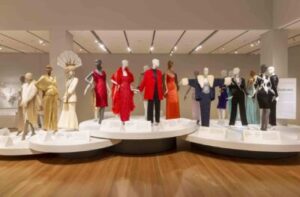 The Peabody Essex Museum (PEM) has reopened this stunning exhibition which now features the influence of Boston Entrepreneur, Yolanda Cellucci. In 1968, entrepreneur Yolanda Cellucci entered Boston’s fashion scene and changed it forever. The city’s retail fashion scene at the time was robust, so Cellucci forged a business model focused on women’s wear and self-care in a holistic, head-turning way. Her shop Yolanda’s, based in Waltham, Massachusetts, became a hotspot for lavish evening and wedding ensembles. In addition to offering high-profile American and international designs, including pieces by Hollywood favorite Bob Mackie, the store provided style consultations, personal shopping, cosmetology services and a day spa with light refreshments — all under one roof. Throughout the late 20th century, “Yolanda’s” became a household name throughout the region and a watchword for glitz and glamor.
The Peabody Essex Museum (PEM) has reopened this stunning exhibition which now features the influence of Boston Entrepreneur, Yolanda Cellucci. In 1968, entrepreneur Yolanda Cellucci entered Boston’s fashion scene and changed it forever. The city’s retail fashion scene at the time was robust, so Cellucci forged a business model focused on women’s wear and self-care in a holistic, head-turning way. Her shop Yolanda’s, based in Waltham, Massachusetts, became a hotspot for lavish evening and wedding ensembles. In addition to offering high-profile American and international designs, including pieces by Hollywood favorite Bob Mackie, the store provided style consultations, personal shopping, cosmetology services and a day spa with light refreshments — all under one roof. Throughout the late 20th century, “Yolanda’s” became a household name throughout the region and a watchword for glitz and glamor.
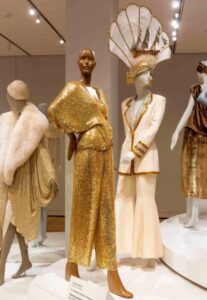 Fashions from Yolanda Cellucci’s collection In 2021, Cellucci generously donated her collection of 57 works of fashion and accessories to PEM, along with archival photographs and materials related to the legacy of Yolanda’s. “PEM is honored to be the steward of this singular and highly memorable chapter of fashion history,” said Petra Slinkard, PEM’s Director of Curatorial Affairs and The Nancy B. Putnam Curator of Fashion and Textiles. “With an eye for all things dazzling, Yolanda Cellucci influenced so many women’s lives by encouraging them to embrace their own power and without apology gain atention as they stepped out into the world,” added Paula Richter, PEM’s Curator overseeing the Yolanda Cellucci collection.
Fashions from Yolanda Cellucci’s collection In 2021, Cellucci generously donated her collection of 57 works of fashion and accessories to PEM, along with archival photographs and materials related to the legacy of Yolanda’s. “PEM is honored to be the steward of this singular and highly memorable chapter of fashion history,” said Petra Slinkard, PEM’s Director of Curatorial Affairs and The Nancy B. Putnam Curator of Fashion and Textiles. “With an eye for all things dazzling, Yolanda Cellucci influenced so many women’s lives by encouraging them to embrace their own power and without apology gain atention as they stepped out into the world,” added Paula Richter, PEM’s Curator overseeing the Yolanda Cellucci collection.
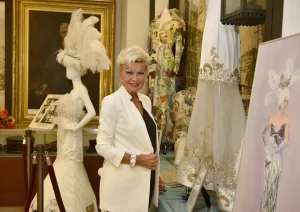 Yolanda Cellucci Throughout her career, Cellucci hosted fashion shows and galas, showcasing her merchandise and raising funds for charities focused on healthcare, the arts and education. Events at Yolanda’s influenced Boston’s society pages for decades. Now in her 80s, Cellucci continues to make an impression through her cable access TV show, a recently published autobiography Beyond the Glitz and Glamour and a series of books written in her daughter’s memory, Lindy Lou and her Dancing Shoes. PEM’s Fashion and Design gallery, located on the third floor of the museum’s new wing, now boasts more than 100 fresh works from the museum’s global fashion and textile collection, including nearly 40 recent acquisitions that spotlight the vibrant and flamboyant collection of Yolanda.. PEM’s Fashion & Design Gallery also features more than 180 examples of contemporary and historic dress, as well as textiles, accessories, sculpture, studio glass and decorative arts and furniture drawn from PEM’s vast and storied collection. Various objects will be rotated into the gallery such as thirteen new ensembles in the Carl & Iris Barrel Apfel Gallery.;
Yolanda Cellucci Throughout her career, Cellucci hosted fashion shows and galas, showcasing her merchandise and raising funds for charities focused on healthcare, the arts and education. Events at Yolanda’s influenced Boston’s society pages for decades. Now in her 80s, Cellucci continues to make an impression through her cable access TV show, a recently published autobiography Beyond the Glitz and Glamour and a series of books written in her daughter’s memory, Lindy Lou and her Dancing Shoes. PEM’s Fashion and Design gallery, located on the third floor of the museum’s new wing, now boasts more than 100 fresh works from the museum’s global fashion and textile collection, including nearly 40 recent acquisitions that spotlight the vibrant and flamboyant collection of Yolanda.. PEM’s Fashion & Design Gallery also features more than 180 examples of contemporary and historic dress, as well as textiles, accessories, sculpture, studio glass and decorative arts and furniture drawn from PEM’s vast and storied collection. Various objects will be rotated into the gallery such as thirteen new ensembles in the Carl & Iris Barrel Apfel Gallery.;
 Shoes from PEM’s renowned footwear collection…the largest in the U.S.; works that focus on China’s influence and fashion’s use of the iconic dragon symbol,; objects that speak to the notions of intimidation and empowerment such as fashions by Donna Karan, a rare Salem Zouave uniform, a Nick Cave Soundsuit and the likeness of a Samurai warrior; and a section looking at body modification that includes an 18th century corset paired with a work from the Fall/Winter 2016 collection from the Parisian fashion house;, along with never before-exhibited jewelry from India, Singapore, Myanmar and Indonesia. For more information visit www.pem.org
Shoes from PEM’s renowned footwear collection…the largest in the U.S.; works that focus on China’s influence and fashion’s use of the iconic dragon symbol,; objects that speak to the notions of intimidation and empowerment such as fashions by Donna Karan, a rare Salem Zouave uniform, a Nick Cave Soundsuit and the likeness of a Samurai warrior; and a section looking at body modification that includes an 18th century corset paired with a work from the Fall/Winter 2016 collection from the Parisian fashion house;, along with never before-exhibited jewelry from India, Singapore, Myanmar and Indonesia. For more information visit www.pem.org
IN ADDITION TO THE ABOVE THERE ARE NUMEROUS VIBRANT AND DIVERSE ONGOING EXHIBITIONS ON DISPLAY AT THE PEM! (www.pem.org)
>>>>>>>>>>>>>>>>>>>>>>>>>>>>>>>>>>>>>>>>>
MUSEUM OF FINE ARTS BOSTON
For complete museum and exhibition details visit www.mfa.org
THROUGH JUNE 22: LANDSCAPE AND LABOR…DUTCH WORKS ON PAPER IN VAN GOGH’S TIME
 Anton Mauve, Digging up a Tree (detail), about 1860s–80s. Transparent and opaque watercolor. Bequest of Elizabeth A. Cotton. Although Vincent van Gogh (1853–1890) is today perhaps the most famous Dutch artist of all, in his own time he was relatively little known, especially when compared to artists of the Hague School. This group, named for the city where many of its members trained and worked, was comprised of those who had different styles but shared a devotion to the depiction of everyday life, looking to the Dutch countryside for their subjects and themes. The Hague School artists achieved international fame, and in the early 1900s U.S. collectors and museums—including the MFA—eagerly sought their works. But over the decades the group’s fame faded. Now, the Museum of Fine Arts, Boston (MFA), has created an exhibition where visitors can see watercolors, prints, and drawings by artists such as Jan Hendrik Weissenbruch (1824–1903), Anton van Rappard (1858–1892), and Anton Mauve (1838–1888). They represent some of the Hague School at its best. Though they are not now household names in the U.S., these figures had a profound impact on the artists of their time and future generations. Mauve, in particular, played a key role in Van Gogh’s early life and career. Van Gogh himself is also represented here, with two early works. The Hague School artists focused on farmers, fisherfolk, laborers, mills, canals, and dunes as their subjects, in part to convey a patriotic love of the countryside. In the densely populated and rapidly industrializing Netherlands, rural subjects recalled a simpler time and a simpler way of life—both of which were quickly disappearing. This exhibition shines a light once more on a neglected group of artists who, working in a changing time, captured vanishing ways of life using modern artistic styles as their tools .For more information visit www.mfa.org
Anton Mauve, Digging up a Tree (detail), about 1860s–80s. Transparent and opaque watercolor. Bequest of Elizabeth A. Cotton. Although Vincent van Gogh (1853–1890) is today perhaps the most famous Dutch artist of all, in his own time he was relatively little known, especially when compared to artists of the Hague School. This group, named for the city where many of its members trained and worked, was comprised of those who had different styles but shared a devotion to the depiction of everyday life, looking to the Dutch countryside for their subjects and themes. The Hague School artists achieved international fame, and in the early 1900s U.S. collectors and museums—including the MFA—eagerly sought their works. But over the decades the group’s fame faded. Now, the Museum of Fine Arts, Boston (MFA), has created an exhibition where visitors can see watercolors, prints, and drawings by artists such as Jan Hendrik Weissenbruch (1824–1903), Anton van Rappard (1858–1892), and Anton Mauve (1838–1888). They represent some of the Hague School at its best. Though they are not now household names in the U.S., these figures had a profound impact on the artists of their time and future generations. Mauve, in particular, played a key role in Van Gogh’s early life and career. Van Gogh himself is also represented here, with two early works. The Hague School artists focused on farmers, fisherfolk, laborers, mills, canals, and dunes as their subjects, in part to convey a patriotic love of the countryside. In the densely populated and rapidly industrializing Netherlands, rural subjects recalled a simpler time and a simpler way of life—both of which were quickly disappearing. This exhibition shines a light once more on a neglected group of artists who, working in a changing time, captured vanishing ways of life using modern artistic styles as their tools .For more information visit www.mfa.org
THROUGH JUNE 22: ROBERT FRANK CENTENNIALEXHIBITION and PUBLICATION
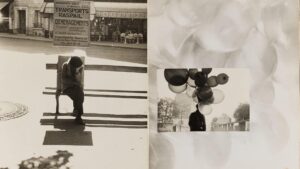 “Robert Frank: Mary’s Book” is supported by the Shelly and Michael Kassen Fund and The Bruce and Laura Monrad Fund for Exhibitions.The Museum of Fine Arts, Boston (MFA), celebrates the centennial of photographer Robert Frank’s birth with an exhibition featuring the personal scrapbook he made for his first wife, titled Mary’s Book. Created in 1949 for Mary Lockspeiser, the album consists of 74 small photographs with Frank’s written inscriptions. They reveal his appreciation for the poetic resonance of objects and spaces. Many of the photographs are devoid of people, although their presence is felt everywhere. He muses on the chairs and streets of Paris with messages interspersed for Mary. The book is a reflection on solitary contemplation that reads like a lyrical poem and compelling personal photographic sequence. This one-of-a-kind, handmade album represents a formative moment in Frank’s career as he experiments with text and image juxtaposition. “Robert Frank: Mary’s Book” includes a selection of spreads from the scrapbook in the Museum’s collection as well as photographs Frank took in Paris, on loan from the artist’s foundation. The Publication is based on the exhibition and will be published in early 2025. Written by Kristen Gresh, the MFA’s Estrellita and Yousuf Karsh Senior Curator of Photographs and Stuart Alexander, a Robert Frank scholar, this is the first time “Mary’s Book” will be fully replicated.. The volume will also include insightful essays from leading scholars, that assist in presenting the album and its pivotal place in the trajectory of the artist’s work. “Robert Frank: Mary’s Book” is supported by the Shelly and Michael Kassen Fund and The Bruce and Laura Monrad Fund for Exhibitions. IN ADDITION, THE MFA IS CELEBRATING ANOTHER PHOTOGRAPHY CENTENNIAL. In 1924, the Museum received a major gift of 27 photographs from the artist Alfred Stieglitz. It was a landmark donation that made the MFA one of the first major American art museums to collect photographs as fine art, placing the institution at the forefront of photography collecting in the United States. Thus the MFA has been collecting photography as fine art .for 100 years. Thanks to Georgia O’Keeffe, widow of Stieglitz, a second large gift of the photographer’s work was made in 1950. This provided the Museum with what is widely recognized as a near perfect overview of the influential photographer’s career. To celebrate the centennial, a special installation of newly acquired large-scale photography will be on view through June 2025 (in two rotations). Along with the exhibit, as a way to feature the multiple narratives in the MFA’s collection,. a new publication will presents the range of works that were not originally made for museum walls, but rather for documentation, the printed page, science, publicity, journalism and artists’ references. Further information can be found at www.mfa.org
“Robert Frank: Mary’s Book” is supported by the Shelly and Michael Kassen Fund and The Bruce and Laura Monrad Fund for Exhibitions.The Museum of Fine Arts, Boston (MFA), celebrates the centennial of photographer Robert Frank’s birth with an exhibition featuring the personal scrapbook he made for his first wife, titled Mary’s Book. Created in 1949 for Mary Lockspeiser, the album consists of 74 small photographs with Frank’s written inscriptions. They reveal his appreciation for the poetic resonance of objects and spaces. Many of the photographs are devoid of people, although their presence is felt everywhere. He muses on the chairs and streets of Paris with messages interspersed for Mary. The book is a reflection on solitary contemplation that reads like a lyrical poem and compelling personal photographic sequence. This one-of-a-kind, handmade album represents a formative moment in Frank’s career as he experiments with text and image juxtaposition. “Robert Frank: Mary’s Book” includes a selection of spreads from the scrapbook in the Museum’s collection as well as photographs Frank took in Paris, on loan from the artist’s foundation. The Publication is based on the exhibition and will be published in early 2025. Written by Kristen Gresh, the MFA’s Estrellita and Yousuf Karsh Senior Curator of Photographs and Stuart Alexander, a Robert Frank scholar, this is the first time “Mary’s Book” will be fully replicated.. The volume will also include insightful essays from leading scholars, that assist in presenting the album and its pivotal place in the trajectory of the artist’s work. “Robert Frank: Mary’s Book” is supported by the Shelly and Michael Kassen Fund and The Bruce and Laura Monrad Fund for Exhibitions. IN ADDITION, THE MFA IS CELEBRATING ANOTHER PHOTOGRAPHY CENTENNIAL. In 1924, the Museum received a major gift of 27 photographs from the artist Alfred Stieglitz. It was a landmark donation that made the MFA one of the first major American art museums to collect photographs as fine art, placing the institution at the forefront of photography collecting in the United States. Thus the MFA has been collecting photography as fine art .for 100 years. Thanks to Georgia O’Keeffe, widow of Stieglitz, a second large gift of the photographer’s work was made in 1950. This provided the Museum with what is widely recognized as a near perfect overview of the influential photographer’s career. To celebrate the centennial, a special installation of newly acquired large-scale photography will be on view through June 2025 (in two rotations). Along with the exhibit, as a way to feature the multiple narratives in the MFA’s collection,. a new publication will presents the range of works that were not originally made for museum walls, but rather for documentation, the printed page, science, publicity, journalism and artists’ references. Further information can be found at www.mfa.org
THROUGH SEPT. 7: VAN GOGH…THE ROULIN FAMILY PORTRAITS
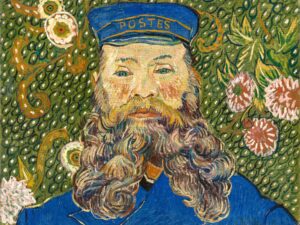 Vincent Van Gogh; Portrait of Joseph Roulin, 1889 Oil on Canvas. The Museum of Modern Art, NY…Gift of Mr. and Mrs. William A. M. Burden, Mr. and Mrs. Paul Rosenbery, Nelson A. Rockefeller, Mr. and Mrs. Armand P. Barlos, The Sidney and Harriet Janis Collection, Mr. And Mrs. Wener E. Josten, and Loula D. Lasker Bequest (all by exchange) (1989)..Photo Credit: Digital Image@ The Museum of Modern Art/Licensed by SCALA/ The Museum Of Fine Arts Boston has placed on exhibit, more than 20 works by Van Gogh (1853–90), including the MFA’s iconic portrait of Postman Joseph Roulin (1888) and the Lullaby: Madame Augustine Roulin Rocking a Cradle (La Berceuse) (1889). In addition it includes important loans from museums such as the Van Gogh Museum in Amsterdam, Museum of Modern Art in New York, and Metropolitan Museum of Art. This retrospect has been further enhanced with a number of key works by earlier Dutch artists along with Japanese woodblock prints which profoundly inspired Van Gogh’s portrait practice by providing critical insight for the artist and his creative process. Letters on display that were written by Postman Roulin further intensify the truth that surrounded the deep bond of friendship which occurred at a major turning point in Van Gogh’s, sad and emotionally tortured life. Between 1888 and 1889, Vincent had moved to Arles, in the south of France and was struggling with his mental health. It was during that time that he created a number of portraits of his neighboring family that included the postman, Joseph Roulin; his wife, Augustine; and their three children: Armand, Camille, and Marcelle.
Vincent Van Gogh; Portrait of Joseph Roulin, 1889 Oil on Canvas. The Museum of Modern Art, NY…Gift of Mr. and Mrs. William A. M. Burden, Mr. and Mrs. Paul Rosenbery, Nelson A. Rockefeller, Mr. and Mrs. Armand P. Barlos, The Sidney and Harriet Janis Collection, Mr. And Mrs. Wener E. Josten, and Loula D. Lasker Bequest (all by exchange) (1989)..Photo Credit: Digital Image@ The Museum of Modern Art/Licensed by SCALA/ The Museum Of Fine Arts Boston has placed on exhibit, more than 20 works by Van Gogh (1853–90), including the MFA’s iconic portrait of Postman Joseph Roulin (1888) and the Lullaby: Madame Augustine Roulin Rocking a Cradle (La Berceuse) (1889). In addition it includes important loans from museums such as the Van Gogh Museum in Amsterdam, Museum of Modern Art in New York, and Metropolitan Museum of Art. This retrospect has been further enhanced with a number of key works by earlier Dutch artists along with Japanese woodblock prints which profoundly inspired Van Gogh’s portrait practice by providing critical insight for the artist and his creative process. Letters on display that were written by Postman Roulin further intensify the truth that surrounded the deep bond of friendship which occurred at a major turning point in Van Gogh’s, sad and emotionally tortured life. Between 1888 and 1889, Vincent had moved to Arles, in the south of France and was struggling with his mental health. It was during that time that he created a number of portraits of his neighboring family that included the postman, Joseph Roulin; his wife, Augustine; and their three children: Armand, Camille, and Marcelle.
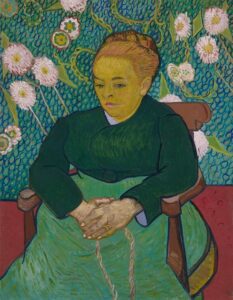 Vincent Van Gogh; Madame Augustine Roulin, “Rocking a Cradle” (La Berceuse) (1889) Bequest of John T. Spaulding On February 20th 1888 Van Gogh moved from Paris to Arles, where he met Joseph Roulin and they became good friends. Despite imagining himself as a husband and father, Van Gogh never married or had children. As he came to terms with this, he found comfort in his relationship with the Roulin family. His portraits of them capture an intimacy that resonates across place and time in families of all kinds—biological, chosen, or observed. This exhibition gives visitors the most in-depth look yet at the emotional underpinnings of some of the beloved artist’s most widely recognized paintings. .Less than a year later, on 21 January 1889, Roulin and his family moved to Marseille. Three months after, Van Gogh moved to Saint-Rémy. Unfortunately Van Gogh began to mentally spiral and by Christmas, while living with Gaugin, he was hospitalized for cutting a portion of his own ear off. Seven months later, Van Gogh tried to tale his own life with a gun. He suffered for a number of days before he ultimately succumbed to his wound while in the company of his brother. Van Gogh’s tender relationship with the postman and his family is a shining light in his life and career, which surprisingly only netted him a sale from one painting. The dedication of this outstanding as well as groundbreaking insular body of works on exhibit are a tribute to not only the artist but to the deep bonds of friendship that existed between the artist and this family. For more information, visit www.mfa.org
Vincent Van Gogh; Madame Augustine Roulin, “Rocking a Cradle” (La Berceuse) (1889) Bequest of John T. Spaulding On February 20th 1888 Van Gogh moved from Paris to Arles, where he met Joseph Roulin and they became good friends. Despite imagining himself as a husband and father, Van Gogh never married or had children. As he came to terms with this, he found comfort in his relationship with the Roulin family. His portraits of them capture an intimacy that resonates across place and time in families of all kinds—biological, chosen, or observed. This exhibition gives visitors the most in-depth look yet at the emotional underpinnings of some of the beloved artist’s most widely recognized paintings. .Less than a year later, on 21 January 1889, Roulin and his family moved to Marseille. Three months after, Van Gogh moved to Saint-Rémy. Unfortunately Van Gogh began to mentally spiral and by Christmas, while living with Gaugin, he was hospitalized for cutting a portion of his own ear off. Seven months later, Van Gogh tried to tale his own life with a gun. He suffered for a number of days before he ultimately succumbed to his wound while in the company of his brother. Van Gogh’s tender relationship with the postman and his family is a shining light in his life and career, which surprisingly only netted him a sale from one painting. The dedication of this outstanding as well as groundbreaking insular body of works on exhibit are a tribute to not only the artist but to the deep bonds of friendship that existed between the artist and this family. For more information, visit www.mfa.org
THROUGH NOV. 9, 2025: DEEP WATERS…FOUR ARTISTS AND THE SEA
 John Akomfrah, still from Vertigo Sea, 2015. Three-channel HD color video installation, 7.1 sound. 48 minutes, 30 seconds. © Smoking Dogs Films; Courtesy Smoking Dogs Films and Lisson Gallery. The Museum of Fine Arts, Boston focuses this exhibit on the works of many generations of artists who have explored the beauties and terrors of the ocean by reflecting on the experiences of those who have lived and lost their lives among the waves. The upcoming exhibition “Deep Waters: Four Artists and the Sea” weaves together artworks by four artists made over centuries and across the Atlantic. The power of the sea can be felt by viewing John Singleton Copley’s “Watson and the Shark” (1778). It in turn, also reverberates in J. M. W Turner’s “Slave Ship” (Slavers Throwing Overboard the Dead and Dying). In addition, as does, “Typhoon Coming On”) (1840), which also influenced art created in the 21st century.. In conjunction with this exhibit the MFA for the first time in New England, debuts John Akomfrah’s “Vertigo Sea” (2015), This is an iconic three-channel film installation that expands on the themes surrounding the heart of the works exhibited. It explores humanity’s tumultuous relationship with the sea and its creatures, along with the ocean’s role in the history of slavery. In “Some People Have Spiritual Eyes I and II” (2020), photographer Ayana V. Jackson takes these thoughts in a new direction. Jackson’s exploration of divinity, femininity, and destiny through self-portraiture is inspired by Drexciya, a mythical aquatic utopia populated by descendants of the pregnant African women who lost their lives in the Atlantic Ocean during the Middle Passage. On November 21, the MFA hosts Akomfrah for a Ruth and Carl J. Shapiro Celebrity Lecture. The artist will dive deeper into his life and work, which is often characterized by investigations into memory, post-colonialism, temporality, and aesthetics, while often exploring the experiences of migrant diasporas globally. For more information and to obtain tickets for the lecture, link here at www.mfa.org
John Akomfrah, still from Vertigo Sea, 2015. Three-channel HD color video installation, 7.1 sound. 48 minutes, 30 seconds. © Smoking Dogs Films; Courtesy Smoking Dogs Films and Lisson Gallery. The Museum of Fine Arts, Boston focuses this exhibit on the works of many generations of artists who have explored the beauties and terrors of the ocean by reflecting on the experiences of those who have lived and lost their lives among the waves. The upcoming exhibition “Deep Waters: Four Artists and the Sea” weaves together artworks by four artists made over centuries and across the Atlantic. The power of the sea can be felt by viewing John Singleton Copley’s “Watson and the Shark” (1778). It in turn, also reverberates in J. M. W Turner’s “Slave Ship” (Slavers Throwing Overboard the Dead and Dying). In addition, as does, “Typhoon Coming On”) (1840), which also influenced art created in the 21st century.. In conjunction with this exhibit the MFA for the first time in New England, debuts John Akomfrah’s “Vertigo Sea” (2015), This is an iconic three-channel film installation that expands on the themes surrounding the heart of the works exhibited. It explores humanity’s tumultuous relationship with the sea and its creatures, along with the ocean’s role in the history of slavery. In “Some People Have Spiritual Eyes I and II” (2020), photographer Ayana V. Jackson takes these thoughts in a new direction. Jackson’s exploration of divinity, femininity, and destiny through self-portraiture is inspired by Drexciya, a mythical aquatic utopia populated by descendants of the pregnant African women who lost their lives in the Atlantic Ocean during the Middle Passage. On November 21, the MFA hosts Akomfrah for a Ruth and Carl J. Shapiro Celebrity Lecture. The artist will dive deeper into his life and work, which is often characterized by investigations into memory, post-colonialism, temporality, and aesthetics, while often exploring the experiences of migrant diasporas globally. For more information and to obtain tickets for the lecture, link here at www.mfa.org
THROUGH DEC. 13, 2026: INTENTIONAL BEAUTY…JEWISH RITUAL ART FROM THE COLLECTION
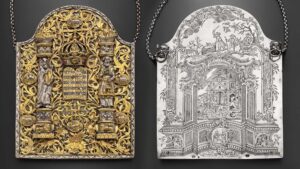 Elimelekh Tzoref, Torah shield, 1781–82. Silver and parcel gilt with enamel, niello, and stones. Museum purchase with funds donated by the Phillip Leonian and Edith Rosenbaum Leonian Charitable Trust, Jacques Aaron Preis, Trustee. The Museum of Fine Arts, Boston (MFA), opens Intentional Beauty: Jewish Ritual Art from the Collection in the Bernard and Barbara Stern Shapiro Gallery in the Art of the Americas Wing. It is the first gallery devoted to Jewish ritual art, or Judaica, at the MFA and in New England. Bringing together 27 objects from Asia, North Africa, Europe and the U.S., the gallery showcases ceremonial items created for the Jewish religious experience that were utilized both at home and in the synagogue. Twenty of these objects are on view at the MFA for the first time. The vast majority of new acquisitions speak to the remarkable geographic and cultural diversity of the Jewish people. This new installation features metalwork, textiles, paintings, furniture and works on paper. This newly dedicated space complements the MFA’s longstanding commitment to integrating Judaica objects and stories across the Museum’s collection galleries, creating dialogues with different cultures and inviting visitors to deepen their engagement. This exhibition is sponsored by the David Berg Foundation. Additional support provided by Lorraine Bressler, the Rita J. and Stanley H. Kaplan Family Foundation, Inc., Lisbeth Tarlow and Stephen Kay, and The Priebatsch Family Fund, in loving memory of Norman Priebatsch. With special gratitude to Marcia and Louis Kamentsky and the Charles and Lynn Schusterman Family Foundation. For more information visit www.mfa.org
Elimelekh Tzoref, Torah shield, 1781–82. Silver and parcel gilt with enamel, niello, and stones. Museum purchase with funds donated by the Phillip Leonian and Edith Rosenbaum Leonian Charitable Trust, Jacques Aaron Preis, Trustee. The Museum of Fine Arts, Boston (MFA), opens Intentional Beauty: Jewish Ritual Art from the Collection in the Bernard and Barbara Stern Shapiro Gallery in the Art of the Americas Wing. It is the first gallery devoted to Jewish ritual art, or Judaica, at the MFA and in New England. Bringing together 27 objects from Asia, North Africa, Europe and the U.S., the gallery showcases ceremonial items created for the Jewish religious experience that were utilized both at home and in the synagogue. Twenty of these objects are on view at the MFA for the first time. The vast majority of new acquisitions speak to the remarkable geographic and cultural diversity of the Jewish people. This new installation features metalwork, textiles, paintings, furniture and works on paper. This newly dedicated space complements the MFA’s longstanding commitment to integrating Judaica objects and stories across the Museum’s collection galleries, creating dialogues with different cultures and inviting visitors to deepen their engagement. This exhibition is sponsored by the David Berg Foundation. Additional support provided by Lorraine Bressler, the Rita J. and Stanley H. Kaplan Family Foundation, Inc., Lisbeth Tarlow and Stephen Kay, and The Priebatsch Family Fund, in loving memory of Norman Priebatsch. With special gratitude to Marcia and Louis Kamentsky and the Charles and Lynn Schusterman Family Foundation. For more information visit www.mfa.org
NOW OPEN: BEYOND BRILLIANCE: HIGHLIGHTS FROM THE JEWELERY COLLECTION
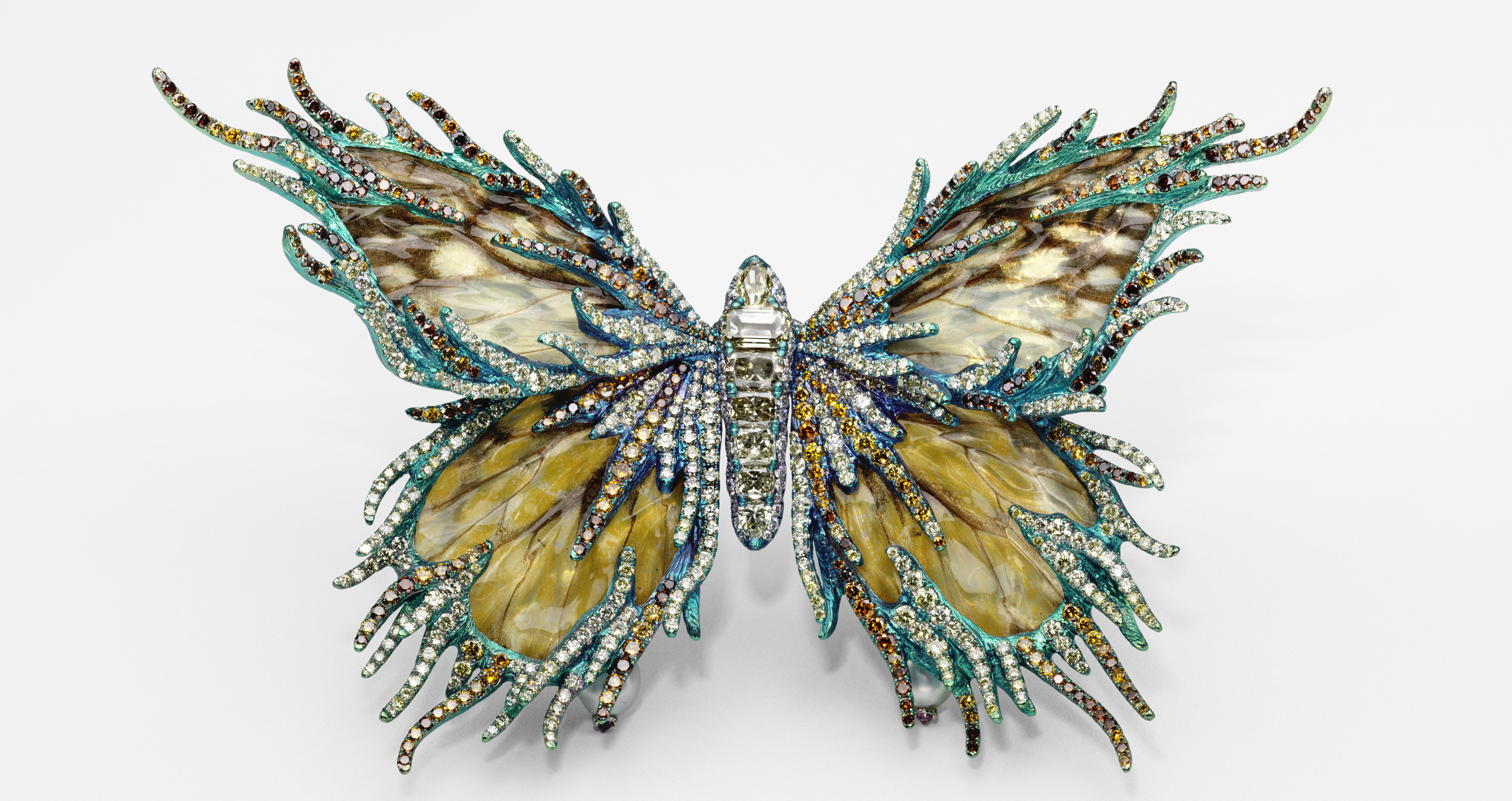 Wallace Chan, Forever Dancing – Bright Star, 2013. Yellow diamond, fancy colored diamonds, rock crystal, mother-of-pearl, butterfly specimen, pearl, and titanium. Gift of Christin Xing and Rex Wong. Reproduced with permission. Believed to be one of the earliest art forms, examples of jewelry date back more than 100,000 years and tell complex stories about human history. The newly renovated Rita J. and Stanley H. Kaplan Family Foundation Gallery features 150 highlights from the Museum’s world-renowned jewelry collection. The gallery spotlights ancient artifacts, fine jewelry, costume jewelry and jewelry by contemporary artists while exploring themes of decorative arts, adornment and messaging. Highlights include an ancient Egyptian broad collar necklace; 19th-century works by Castellani and Carlo Giuliano; 20th-century designs by Marcus & Co., Tiffany & Co., and Bulgari; René Boivin’s starfish brooch from 1937; and fashion jewelry by Chanel, Dior, and Elsa Peretti. Also featured are new acquisitions of contemporary jewelry by Christian and Yasmin Hemmerle, Wallace Chan and Feng J. With ornaments crafted over 4,000 years and reflecting global cultures, Beyond Brilliance: Highlights from the Jewelry Collection champions the great depth and breadth of the MFA’s collection. The exhibition is presented in a jewel box-inspired space, organized into thematic groupings. First area surrounds the Decorative Arts section includes outstanding examples of 19th-and 20th-century design movements like Art Nouveau, Arts and Crafts, Art Deco, Surrealism and Modernism, demonstrating the deep connection between artistic expression and jewelry. Offering an expanded look at materials used to make jewelry, this section features jewelry made in gold and silver, diamonds, colored gemstones, pearls and plastics. Extraordinary craftsmanship and the mastery of materials are seen in techniques like micromosaic, granulation and enamel.
Wallace Chan, Forever Dancing – Bright Star, 2013. Yellow diamond, fancy colored diamonds, rock crystal, mother-of-pearl, butterfly specimen, pearl, and titanium. Gift of Christin Xing and Rex Wong. Reproduced with permission. Believed to be one of the earliest art forms, examples of jewelry date back more than 100,000 years and tell complex stories about human history. The newly renovated Rita J. and Stanley H. Kaplan Family Foundation Gallery features 150 highlights from the Museum’s world-renowned jewelry collection. The gallery spotlights ancient artifacts, fine jewelry, costume jewelry and jewelry by contemporary artists while exploring themes of decorative arts, adornment and messaging. Highlights include an ancient Egyptian broad collar necklace; 19th-century works by Castellani and Carlo Giuliano; 20th-century designs by Marcus & Co., Tiffany & Co., and Bulgari; René Boivin’s starfish brooch from 1937; and fashion jewelry by Chanel, Dior, and Elsa Peretti. Also featured are new acquisitions of contemporary jewelry by Christian and Yasmin Hemmerle, Wallace Chan and Feng J. With ornaments crafted over 4,000 years and reflecting global cultures, Beyond Brilliance: Highlights from the Jewelry Collection champions the great depth and breadth of the MFA’s collection. The exhibition is presented in a jewel box-inspired space, organized into thematic groupings. First area surrounds the Decorative Arts section includes outstanding examples of 19th-and 20th-century design movements like Art Nouveau, Arts and Crafts, Art Deco, Surrealism and Modernism, demonstrating the deep connection between artistic expression and jewelry. Offering an expanded look at materials used to make jewelry, this section features jewelry made in gold and silver, diamonds, colored gemstones, pearls and plastics. Extraordinary craftsmanship and the mastery of materials are seen in techniques like micromosaic, granulation and enamel.
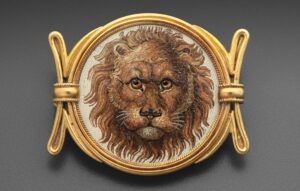 Castellani, micromosaic lion brooch, about 1870. Gold and glass (micromosaic). Gift of Susan Beth Kaplan. New acquisitions in this section include a brooch fashioned with the rare Paraiba tourmaline gemstone by Feng J (2021).
Castellani, micromosaic lion brooch, about 1870. Gold and glass (micromosaic). Gift of Susan Beth Kaplan. New acquisitions in this section include a brooch fashioned with the rare Paraiba tourmaline gemstone by Feng J (2021).
The next area is dedicated to Adornment which emphasizes jewelry’s connection to the body and clothing to remind visitors of the creative ways that it has functioned as part of global visual culture spanning thousands of years. For the opening of the gallery, the paper rotation features two 1920s fashion plates to demonstrate how jewelry and fashion function together to create an overall look. This section celebrates new acquisitions by Anna Hu, twentieth-century designs by Marcus & Co. and Bulgari along with fashion jewelry by Chanel and Dior. And, finally, the Messaging section explores how jewelry can be used to communicate—whether to tell private, personal stories or indicate rank, marital status or religious beliefs. This space includes jewelry formerly worn by First Lady Mary Todd Lincoln,
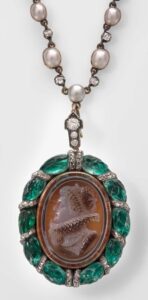 a necklace by Charlotte Newman featuring the profile of Elizabeth I and a turquoise eagle brooch presented by Queen Victoria to each of her train bearers on her wedding day. A pair of earrings by Hemmerle include the Bavarian crown, paying tribute to the German jeweler’s heritage. Additionally, a center case in the gallery will rotate annually, featuring objects that together illustrate the timeless human desire to self-fashion, collect and create. The first rotation pays tribute to Italian designer Elsa Peretti, who died in 2021 and is remembered with such designs as the Open Heart pendant and Bone Cuff bracelets. She is one of the 20th century’s most important designers. For more information regarding this stunning retrospective surrounding the fine art of jewelry, visit www.mfa.org
a necklace by Charlotte Newman featuring the profile of Elizabeth I and a turquoise eagle brooch presented by Queen Victoria to each of her train bearers on her wedding day. A pair of earrings by Hemmerle include the Bavarian crown, paying tribute to the German jeweler’s heritage. Additionally, a center case in the gallery will rotate annually, featuring objects that together illustrate the timeless human desire to self-fashion, collect and create. The first rotation pays tribute to Italian designer Elsa Peretti, who died in 2021 and is remembered with such designs as the Open Heart pendant and Bone Cuff bracelets. She is one of the 20th century’s most important designers. For more information regarding this stunning retrospective surrounding the fine art of jewelry, visit www.mfa.org
NOW OPEN: NEWLY TRANSFORMED ARTS OF JAPAN GALLERIES
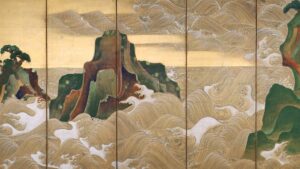 Ogata Kōrin, Waves at Matsushima (detail), 18th century. Six-panel folding screen; ink, color, and gold on paper. Fenollosa-Weld Collection The collection of Japanese art at the Museum of Fine Arts, Boston (MFA), is one of the most comprehensive in the world. Five newly transformed galleries showcasing nearly 200 highlights—including painting, sculpture, decorative arts and selections from the Museum’s vast collection of ukiyo-e prints opened May 11th. Displays will change regularly, presenting icons of the collection and new acquisitions—giving visitors the opportunity to see even more works in a setting that honors and celebrates Japan’s rich history and cultural legacy. The renovations are made possible through the generosity of a community of supporters including individuals, families and corporate partners.The new Arts of Japan galleries include the Japanese Buddhist Temple Room—a visitor favorite— which originally opened in 1909. The contemplative space has been fully renovated and features seven sculptures that have undergone extensive conservation treatment beginning in 2018. A ritual to rededicate the gallery took place on May 11, conducted by a delegation of monks from Miidera, one of the largest temples in Japan. The ritual was simulcasted from the Temple Room to the MFA’s Remis Auditorium, and the monks greeted the public afterward, inviting visitors to explore the newly opened galleries. The MFA has a historic relationship with Miidera, where the early founders of the Museum’s Japanese collection—Ernest Fenollosa, William Sturgis Bigelow and Okakura Kakuzō—studied Tendai Esoteric Buddhism. It is also where Fenollosa and Bigelow are buried today. “The story of Japanese art at the MFA is ever-evolving, and we’re excited to present this next chapter,” said Anne Nishimura Morse, William and Helen Pounds Senior Curator of Japanese Art. “We’re very fortunate to have a truly remarkable collection here in Boston, which was the first of its kind in the U.S. when it was established in 1890 and has since grown into the largest outside Japan. I’m very excited for visitors to see some of their old favorites and discover new works in these galleries, which span from historical to contemporary masterpieces.” The renovation of gallery 280 was made possible with generous support from Caroline and John Rutherfurd. The renovation gallery 278A of the Buddhist Temple Room was generously supported by UNIQLO USA, the Vance Wall Foundation, the Massachusetts Cultural Council, Lisbeth Tarlow and Stephen Kay, Bettina Burr, Dainippon Sumitomo Pharma Co. Ltd., and Mr. and Mrs. Charles C. Cunningham Jr. For further information visit www.mfa.org
Ogata Kōrin, Waves at Matsushima (detail), 18th century. Six-panel folding screen; ink, color, and gold on paper. Fenollosa-Weld Collection The collection of Japanese art at the Museum of Fine Arts, Boston (MFA), is one of the most comprehensive in the world. Five newly transformed galleries showcasing nearly 200 highlights—including painting, sculpture, decorative arts and selections from the Museum’s vast collection of ukiyo-e prints opened May 11th. Displays will change regularly, presenting icons of the collection and new acquisitions—giving visitors the opportunity to see even more works in a setting that honors and celebrates Japan’s rich history and cultural legacy. The renovations are made possible through the generosity of a community of supporters including individuals, families and corporate partners.The new Arts of Japan galleries include the Japanese Buddhist Temple Room—a visitor favorite— which originally opened in 1909. The contemplative space has been fully renovated and features seven sculptures that have undergone extensive conservation treatment beginning in 2018. A ritual to rededicate the gallery took place on May 11, conducted by a delegation of monks from Miidera, one of the largest temples in Japan. The ritual was simulcasted from the Temple Room to the MFA’s Remis Auditorium, and the monks greeted the public afterward, inviting visitors to explore the newly opened galleries. The MFA has a historic relationship with Miidera, where the early founders of the Museum’s Japanese collection—Ernest Fenollosa, William Sturgis Bigelow and Okakura Kakuzō—studied Tendai Esoteric Buddhism. It is also where Fenollosa and Bigelow are buried today. “The story of Japanese art at the MFA is ever-evolving, and we’re excited to present this next chapter,” said Anne Nishimura Morse, William and Helen Pounds Senior Curator of Japanese Art. “We’re very fortunate to have a truly remarkable collection here in Boston, which was the first of its kind in the U.S. when it was established in 1890 and has since grown into the largest outside Japan. I’m very excited for visitors to see some of their old favorites and discover new works in these galleries, which span from historical to contemporary masterpieces.” The renovation of gallery 280 was made possible with generous support from Caroline and John Rutherfurd. The renovation gallery 278A of the Buddhist Temple Room was generously supported by UNIQLO USA, the Vance Wall Foundation, the Massachusetts Cultural Council, Lisbeth Tarlow and Stephen Kay, Bettina Burr, Dainippon Sumitomo Pharma Co. Ltd., and Mr. and Mrs. Charles C. Cunningham Jr. For further information visit www.mfa.org
CURRENTLY: MICHAELINA WAUTIER EXHIBITION IN THE AMERICAS
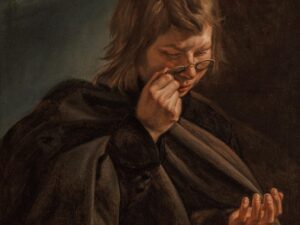 The Center for Netherlandish Art at the Museum of Fine Arts, Boston presents the first exhibition in the Americas dedicated to the art of Michaelina Wautier (1614–1689), a painter from Brussels all but forgotten until the recent rediscovery of her work. Now on view, the exhibition is centered around her rare series The Five Senses (1650), a set of five pictures that were virtually unknown until it was acquired by Rose-Marie and Eijk van Otterloo and lent to the MFA in 2020. They are joined by Wautier’s remarkable Self-Portrait (above) on loan from a private collection and on public view in the U.S. for the first time. Wautier’s technique, process and training are mysterious. Few records about her life exist, due in part to her gender. This exhibition, organized by the MFA’s Center for Netherlandish Art in collaboration with a professor and six doctoral students from Brown University, presents new scholarship about the artist and her unusual career as a female painter working in mid-17th-century Brussels. The Five Senses and the Self-Portrait, all of which have only been attributed to Wautier in recent years, are among fewer than 40 known works by the artist. Wautier focuses on boys—a different model in each painting—performing everyday activities in her detailed portrayals of Sight, Hearing, Smell, Taste and Touch. Accompanying prints by her predecessors and contemporaries, including Cornelis Cort (1533–1578) and Johannes Gillisz. van Vliet (about 1610–about 1640), demonstrate Wautier’s originality, showcasing how she defied a convention at the time of depicting the senses as experienced by idealized women. In her Self-Portrait, Wautier presents herself both in a formal aristocratic setting and as a professional artist, facing an easel and holding painting tools. Together, these extraordinary pictures are exemplary of Wautier’s unique style and brushwork. Additionally, the exhibition features a print after a now-lost portrait by Wautier from the MFA’s collection that has never been on view. Michaelina Wautier and the Five Senses: Innovation in 17th-Century Flemish Painting is accompanied by the first volume of the digital publication series CNA Studies, available on mfa.org and featuring essays by the six organizing students: Yannick Etoundi, Sophie Higgerson, Emily Hirsch, Regina Noto, Mohadeseh Salari Sardari and Dandan Xu is edited by Professor Jeffrey Muller. The exhibition and the Center for Netherlandish Art’s Gallery for Innovative Scholarship is sponsored by Northern Trust. Additional support from the Government of Flanders – Flanders Investment & Trade. Further information may be found at www.mfa.org
The Center for Netherlandish Art at the Museum of Fine Arts, Boston presents the first exhibition in the Americas dedicated to the art of Michaelina Wautier (1614–1689), a painter from Brussels all but forgotten until the recent rediscovery of her work. Now on view, the exhibition is centered around her rare series The Five Senses (1650), a set of five pictures that were virtually unknown until it was acquired by Rose-Marie and Eijk van Otterloo and lent to the MFA in 2020. They are joined by Wautier’s remarkable Self-Portrait (above) on loan from a private collection and on public view in the U.S. for the first time. Wautier’s technique, process and training are mysterious. Few records about her life exist, due in part to her gender. This exhibition, organized by the MFA’s Center for Netherlandish Art in collaboration with a professor and six doctoral students from Brown University, presents new scholarship about the artist and her unusual career as a female painter working in mid-17th-century Brussels. The Five Senses and the Self-Portrait, all of which have only been attributed to Wautier in recent years, are among fewer than 40 known works by the artist. Wautier focuses on boys—a different model in each painting—performing everyday activities in her detailed portrayals of Sight, Hearing, Smell, Taste and Touch. Accompanying prints by her predecessors and contemporaries, including Cornelis Cort (1533–1578) and Johannes Gillisz. van Vliet (about 1610–about 1640), demonstrate Wautier’s originality, showcasing how she defied a convention at the time of depicting the senses as experienced by idealized women. In her Self-Portrait, Wautier presents herself both in a formal aristocratic setting and as a professional artist, facing an easel and holding painting tools. Together, these extraordinary pictures are exemplary of Wautier’s unique style and brushwork. Additionally, the exhibition features a print after a now-lost portrait by Wautier from the MFA’s collection that has never been on view. Michaelina Wautier and the Five Senses: Innovation in 17th-Century Flemish Painting is accompanied by the first volume of the digital publication series CNA Studies, available on mfa.org and featuring essays by the six organizing students: Yannick Etoundi, Sophie Higgerson, Emily Hirsch, Regina Noto, Mohadeseh Salari Sardari and Dandan Xu is edited by Professor Jeffrey Muller. The exhibition and the Center for Netherlandish Art’s Gallery for Innovative Scholarship is sponsored by Northern Trust. Additional support from the Government of Flanders – Flanders Investment & Trade. Further information may be found at www.mfa.org
IN ADDITION THERE ARE OVER 26 ONGOING GALLERY HIGHLIGHTS TO EXPLORE AT THE MFA…
>>>>>>>>>>>>>>>>>>>>>>>>>>>>>>>>>>>>>>>
ISABELLA STEWART GARDENER MUSEUM
See complete museum information under “MUSEUMS” www.gardnermuseum.org
>>>>>>>>>>>>>>>>>>>>>>>>>>>>>>>>>>>>>>
INSTITUTE OF CONTEMPORARY ART
www.icaboston.org See complete museum information under “MUSEUMS”
>>>>>>>>>>>>>>>>>>>>>>>>>>>>>>>>>>>>>>>>
GALLERIES
ONGOING: LANOUE FINE ART GALLERY
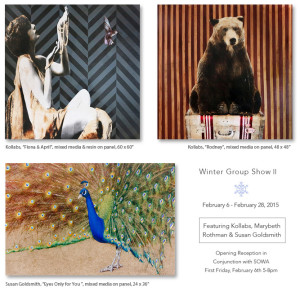 Located at 450 Harrison Ave. #31 in Boston (At Thayer Street, on the ground level), in the SOWA ART DISTRICT, this well established gallery hosts outstanding contemporary artists from around the world. For more information about current and up and coming artists go to www.LanoueGallery.com
Located at 450 Harrison Ave. #31 in Boston (At Thayer Street, on the ground level), in the SOWA ART DISTRICT, this well established gallery hosts outstanding contemporary artists from around the world. For more information about current and up and coming artists go to www.LanoueGallery.com
ONGOING: MOVIMIENTO GALLERY
 Paul Walcott “Triple Entendre” Paul Walcott has established a new Gallery space in the dynamic SOWA art’s district at 450 Harrison Ave, 4th Floor, Suite #401, in Boston. He invites all to this new Gallery space in the dynamic SOWA art’s district in Boston! Each month, the Gallery features some of the most talented and innovative artists in New England as well as ongoing displays of art furniture. MOVIMIENTO is also the home of Tango Embrace, where they host a variety of tango events including workshops and private classes. For more information go to www.MOVIMIENTOspace.com.
Paul Walcott “Triple Entendre” Paul Walcott has established a new Gallery space in the dynamic SOWA art’s district at 450 Harrison Ave, 4th Floor, Suite #401, in Boston. He invites all to this new Gallery space in the dynamic SOWA art’s district in Boston! Each month, the Gallery features some of the most talented and innovative artists in New England as well as ongoing displays of art furniture. MOVIMIENTO is also the home of Tango Embrace, where they host a variety of tango events including workshops and private classes. For more information go to www.MOVIMIENTOspace.com.
